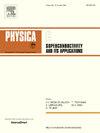Enhancing Hastelloy tape surfaces flattening efficiency via autonomously designed SDP system derived Y2O3 coatings
IF 1
3区 物理与天体物理
Q4 PHYSICS, APPLIED
Physica C-superconductivity and Its Applications
Pub Date : 2025-06-02
DOI:10.1016/j.physc.2025.1354744
引用次数: 0
Abstract
The widespread application of second-generation high-temperature superconducting (2G HTS) tapes has elevated demand for surface smoothing of long-length Hastelloy tapes utilizing simple and low-cost strategies. Amorphous Y2O3 has been used to flatten the long-length Hastelloy tape surfaces via solution deposition planarization (SDP). In this work, the autonomously designed SDP system is applied to flatten the Hastelloy surface while significantly increasing progress rate. As a result, lifting speed up to 75 m/h, while the root mean square (RMS) roughness on Hastelloy tape surfaces was reduced from 28.13 nm to 0.76 nm over 5 × 5 μm² areas. These are superior to those of the state-of-the-art SDP lifting speeds. Additionally, the surface flattening process was elaborated through power spectral density (PSD). The Hastelloy tape surfaces have been confirmed to form a well-biaxially textured MgO buffer layer. The autonomously designed SDP system shed light on an effective strategy for flattening long-length Hastelloy tape surfaces.
通过自主设计的SDP系统衍生的Y2O3涂层,提高哈氏合金带表面平坦化效率
随着第二代高温超导(2G HTS)带的广泛应用,对采用简单、低成本的方法实现长哈氏合金带的表面平滑提出了更高的要求。采用溶液沉积平面化(SDP)技术将非晶Y2O3用于长哈氏合金带表面的平面化。在这项工作中,自主设计的SDP系统应用于哈氏合金表面的平整,同时显著提高了进度速度。结果,提升速度可达75 m/h,而哈氏合金带表面在5 × 5 μm²面积上的均方根粗糙度(RMS)从28.13 nm降至0.76 nm。这些都优于那些国家的最先进的SDP起重速度。此外,通过功率谱密度(PSD)对表面平坦化过程进行了阐述。哈氏合金带表面已被证实形成良好的双轴织构MgO缓冲层。自主设计的SDP系统揭示了一种有效的策略,使长哈氏合金胶带表面变平。
本文章由计算机程序翻译,如有差异,请以英文原文为准。
求助全文
约1分钟内获得全文
求助全文
来源期刊
CiteScore
2.70
自引率
11.80%
发文量
102
审稿时长
66 days
期刊介绍:
Physica C (Superconductivity and its Applications) publishes peer-reviewed papers on novel developments in the field of superconductivity. Topics include discovery of new superconducting materials and elucidation of their mechanisms, physics of vortex matter, enhancement of critical properties of superconductors, identification of novel properties and processing methods that improve their performance and promote new routes to applications of superconductivity.
The main goal of the journal is to publish:
1. Papers that substantially increase the understanding of the fundamental aspects and mechanisms of superconductivity and vortex matter through theoretical and experimental methods.
2. Papers that report on novel physical properties and processing of materials that substantially enhance their critical performance.
3. Papers that promote new or improved routes to applications of superconductivity and/or superconducting materials, and proof-of-concept novel proto-type superconducting devices.
The editors of the journal will select papers that are well written and based on thorough research that provide truly novel insights.

 求助内容:
求助内容: 应助结果提醒方式:
应助结果提醒方式:


